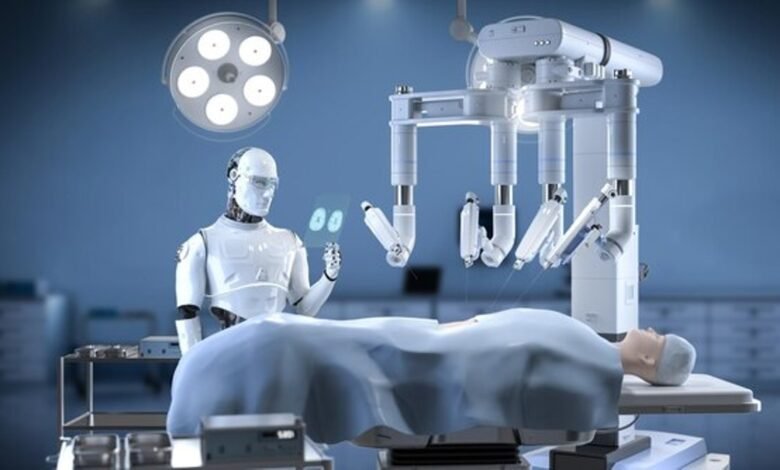The Best Robotic Surgery Systems for 2024

In recent years, the field of medical technology has witnessed remarkable advancements, particularly in the realm of robotic surgery systems. These cutting-edge technologies have revolutionized the way surgeries are performed, offering precision, efficiency, and improved patient outcomes. As we step into 2024, let’s explore the best robotic surgery systems that are making waves in the medical world.
Understanding Robotic Surgery
Robotic surgery represents a remarkable advancement in the field of medicine, offering both patients and surgeons a host of benefits. This innovative approach utilizes robotic systems to assist surgeons during various medical procedures, ensuring precision, efficiency, and improved outcomes.
Read More: The Future of Healthcare: Innovations in the World
How Robotic Surgery Works
At the heart of robotic surgery is a sophisticated robotic system equipped with specialized tools, cameras, and robotic arms. The surgeon, seated at a console, controls these robotic arms with great precision. The system translates the surgeon’s hand movements into precise actions, allowing for intricate and controlled maneuvers within the patient’s body.
The primary components of a robotic surgical system typically include:
Robotic Arms: These flexible robotic arms mimic the dexterity of a surgeon’s hand, capable of delicate movements and rotations.
High-Definition Cameras: Miniaturized cameras provide a 3D view of the surgical site, offering enhanced visibility and clarity.
Surgical Tools: The robotic arms hold a range of specialized surgical instruments, which can be interchanged as needed during the procedure.
This combination of advanced technology and surgical expertise allows for procedures that are far more precise and less invasive than traditional open surgeries.
Advantages of Robotic Surgery
Robotic surgery systems have gained popularity in the medical community due to their numerous advantages:
Enhanced Precision
The precision offered by robotic systems is unparalleled. Surgeons can manipulate the robotic arms with incredible accuracy, making procedures more exact and reducing the risk of errors.
Minimally Invasive
Robotic surgery is minimally invasive, meaning it requires only small incisions rather than large, open cuts. Smaller incisions result in less pain, reduced scarring, and quicker recovery times for patients.
3D Visualization
Most robotic surgical systems provide 3D visualization, offering surgeons a comprehensive and detailed view of the surgical area. This enhanced visual information assists in precise decision-making during the procedure.
Reduced Blood Loss
The precision of robotic surgery often leads to reduced blood loss during surgeries. This is especially important in complex procedures where excessive bleeding can be life-threatening.
These advantages make robotic surgery an attractive option for a wide range of medical conditions and procedures, from urology and gynecology to cardiac and gastrointestinal surgeries.
As technology continues to advance, robotic surgery is poised to become even more sophisticated, further improving patient outcomes and expanding the scope of surgical possibilities. In the next sections, we will delve into the top robotic surgery systems that are anticipated to make significant contributions to the field in 2024.
Advantages of Robotic Surgery
Robotic surgery systems offer several advantages that have made them increasingly popular in the medical community.
Enhanced Precision
One of the primary benefits of robotic surgery is its exceptional precision. The robotic arms can make precise movements that are often beyond the capabilities of the human hand.
Minimally Invasive
Robotic surgery is minimally invasive, which means smaller incisions, reduced scarring, and quicker recovery times for patients.
3D Visualization
Most robotic surgery systems provide 3D visualization, giving surgeons a clearer view of the surgical site.
Reduced Blood Loss
The precision of robotic surgery leads to reduced blood loss during procedures, contributing to improved patient safety.
Top Robotic Surgery Systems for 2024
Now, let’s take a closer look at the best robotic surgery systems that are set to make a significant impact in 2024.
da Vinci Surgical System
The da Vinci Surgical System is perhaps the most well-known robotic surgery system. It offers a high degree of precision and versatility, making it suitable for various surgical procedures, including urological and gynecological surgeries.
Medtronic Hugo™
The Medtronic Hugo™ is a state-of-the-art robotic surgery system designed to enhance the surgeon’s capabilities. It provides haptic feedback, allowing the surgeon to feel tissue resistance, further improving precision.
Intuitive Surgical’s Ion™ Endoluminal System
The Ion™ Endoluminal System by Intuitive Surgical is designed for minimally invasive lung biopsy procedures. Its compact size and advanced imaging capabilities make it a game-changer in the field of respiratory medicine.
TransEnterix Senhance® Surgical System
The Senhance® Surgical System by TransEnterix offers impressive robotic assistance for laparoscopic surgeries. It’s known for its responsiveness and ergonomic design, making it a favorite among surgeons.
CMR Surgical Versius®
The Versius® surgical robot by CMR Surgical is gaining recognition for its affordability and flexibility. It can be easily adapted for various surgical specialties, making it a valuable addition to any hospital.
Titan Medical SPORT™ Surgical System
The SPORT™ Surgical System by Titan Medical is set to be a game-changer in the world of robotic surgery. With multi-articulating arms and advanced vision systems, it provides unmatched surgical precision.
Robocath R-One™
Robocath’s R-One™ robot specializes in vascular procedures. It offers remote operation capabilities, reducing the need for surgeons to be physically present, especially in emergency situations.
Vicarious Surgical’s Virtual Reality Robotic System
Vicarious Surgical’s Virtual Reality Robotic System combines robotics and virtual reality to provide surgeons with an immersive experience. This technology has the potential to redefine surgical training.
The Future of Robotic Surgery
As we look ahead to the future of robotic surgery, it’s clear that this innovative field is poised for remarkable growth and evolution. With continuous advancements in technology and increasing acceptance within the medical community, the future holds great promise for further enhancing surgical precision and patient care.
Technological Advancements
The driving force behind the future of robotic surgery lies in technological advancements. These innovations are set to transform the landscape of healthcare in several key ways:
Artificial Intelligence Integration
The integration of artificial intelligence (AI) into robotic surgery systems is on the horizon. AI algorithms can analyze vast amounts of data in real-time, providing surgeons with instant insights during procedures. This can enhance decision-making, improve outcomes, and reduce the margin of error.
Enhanced Imaging
Future robotic surgery systems will likely feature even more advanced imaging capabilities. This could include improved 3D visualization, augmented reality overlays, and real-time tissue analysis. Surgeons will have access to unprecedented levels of detail, making surgeries safer and more precise.
Remote Surgery
The concept of remote surgery is gaining traction. With ultra-low latency communication networks, surgeons may be able to perform procedures on patients located in different parts of the world. This could be a game-changer for reaching underserved populations and providing expert care globally.
Miniaturization
Robotic systems are becoming more compact and versatile. Miniaturized robots could perform procedures in hard-to-reach areas of the body with greater ease, expanding the range of surgeries that can benefit from robotic assistance.
Expanding Surgical Applications
As technology advances, the applications of robotic surgery are expected to broaden significantly. While robotic systems have already made their mark in various fields, including urology, gynecology, and cardiothoracic surgery, they are likely to venture into new territories. These may include neurosurgery, ophthalmology, and orthopedics.
Improved Training and Accessibility
With the increasing prevalence of robotic surgery, the training and certification processes for surgeons are expected to become more streamlined and widely accessible. This will ensure that more medical professionals can harness the power of these cutting-edge systems, ultimately benefiting a broader range of patients.
Patient-Centered Care
The future of robotic surgery is fundamentally patient-centered. The focus will remain on improving patient outcomes, reducing recovery times, and minimizing complications. Robotic surgery systems will continue to drive advancements in personalized medicine, tailoring procedures to each patient’s unique anatomy and needs.
In conclusion, the future of robotic surgery is bright and full of promise. Technological innovations, expanding applications, improved training, and a steadfast commitment to patient-centered care will continue to shape this field. As we move forward, patients can look forward to safer, more precise, and less invasive surgical options, thanks to the incredible capabilities of robotic surgery systems.
Read More: Preventative Healthcare: Key Strategies for a Healthier Tomorrow
Conclusion
Robotic surgery systems have ushered in a new era of surgical precision and patient care. In 2024, the best robotic surgery systems, such as the da Vinci Surgical System, Medtronic Hugo™, and others, are pushing the boundaries of what’s possible in the operating room. As technology continues to evolve, the future of robotic surgery looks promising, promising safer, less invasive, and more precise procedures for patients.
In the years to come, we can expect to witness an ever-evolving landscape of surgical possibilities, where robots work alongside skilled surgeons to push the boundaries of medical excellence. The best is yet to come, and patients can look forward to a future where robotic surgery continues to transform lives, one precise procedure at a time.
FAQs
Are robotic surgeries more expensive than traditional surgeries?
Robotic surgeries can be more expensive due to the initial cost of purchasing and maintaining robotic systems. However, they may lead to cost savings in terms of shorter hospital stays and quicker recovery times.
Is robotic surgery risk-free?
While robotic surgery offers numerous benefits, no surgical procedure is entirely risk-free. It’s essential to discuss potential risks and benefits with your surgeon before undergoing robotic surgery.
Can any surgeon operate robotic systems?
Surgeons require specialized training to operate robotic systems effectively. They must undergo certification and hands-on training to ensure patient safety.
How long does it take to recover from a robotic surgery?
Recovery times vary depending on the type of surgery and the patient’s overall health. In general, robotic surgery often leads to shorter recovery times compared to traditional open surgery.
What types of surgeries can be performed using robotic systems?
Robotic systems are versatile and can be used for a wide range of surgeries, including urological, gynecological, cardiovascular, and gastrointestinal procedures.







